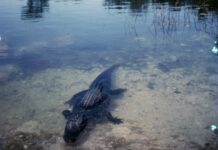
One of the things distinguishing the Keys from Florida’s sand-based barrier islands like Captiva, Sanibel, and Anna Maria Island is their construction. By and large, the Florida Keys are based on limestone pedestals, set in their ways and relatively unmoved by the forces of wind and tide. As with everything, there are exceptions. For instance, in the Dry Tortugas, tidal forces, storms, and currents cause the sandy Middle Key to appear and disappear periodically.
Outside of the Dry Tortugas, not every key has survived the test of time. Three of these keys bear the notable names of Alligator, Sombrero, and Looe. As noted on the U.S. Coast Survey conducted by A.D. Bache (1848-1852), Alligator Key was located offshore of the Matecumbe keys. That area is recognized as home to Alligator Reef and Alligator Lighthouse today. A story involving the island was featured in an 1874 edition of Lippincott’s Magazine. Alligator Key was described as “…about a mile and a half long, elevated but two or three feet above the sea, and bordered with a growth of mangroves, upon which grow oysters and other mollusks.”
A group had been traveling to Key West aboard a ship that stopped at Alligator Key for turtles and eggs. When the group ventured ashore, they waited for the lumbering reptiles to heave, slap and splash out of the Atlantic-facing shallows and onto the sandy island. That night, two turtles lumbered ashore. No one approached as the turtles dug their nests, deposited their eggs, and labored to cover them up. As the two exhausted mothers made their way back to the surf, one was captured and turned on its back. The other escaped into the warm, clear Atlantic.
Over time, Alligator Key was subject to tidal and storm forces, erased from its offshore hold and left off nautical charts. It would not be the only one. The easternmost key along the island chain was once a small spit of land referred to in some records as Dry Banks and identified in others as Sombrero Kay. J.W. Norie wrote of the island in his “Sailing directions for the Gulf”: “5 miles S. 1/4 E. from the west end of Cayo Vaca, there is a small sandy kay on the reef, called by the Spaniards Cayo Sombrero; this is the easternmost kay on the reef.”
In John Lee Williams’ early account of Florida, he described Kay Sombrero as “the easternmost islet on the reef. It is situated six or seven miles N.E. from Bahia Honda, and four miles S.W. from Knight’s Key, the western key of the Vaccas group. It is but a patch of rock, covered with a few mangroves and pieces of wreck.” Today, this is the general area of the Sombrero Key Lighthouse and the reason why the word “key” is part of the lighthouse’s name. At 142 feet, Sombrero is the tallest of all the lights marking the Florida Reef.
Sombrero Key was not the last island in the chain to disappear. One of the most popular snorkeling reefs in the Lower Keys is not called a reef but, instead, Looe Key. Not a speck of land is in sight. It has not always been the case. In 1744, the 44-gun H.M.S. Looe hit a shallow reef offshore of Ramrod Key. It was dark. They were sailing by starlight. To the men on watch, one moment it appeared to be clear sailing, and the next, they saw the frothy white of waves breaking over a reef.
Alarms were sounded and evasive actions taken, but the Looe’s rudder struck the reef, broke off, and the ship, unable to steer, was pounded by swells and beaten against the coral beds. Rather than go down with the ship, 274 sailors escaped to a nearby spit of land. The ship’s captain noted “a small beach of an islet was approximately 300 yards long and 100 yards wide.”
The small stretch of land became known as Looe Key. The land has since disappeared, and today the shallow coral reefs are recognized as Looe Key. It is home to one of the more offbeat Florida Keys events, the Looe Key Underwater Music Festival. Bill Becker, then a disc jockey and news director at U.S. 1 Radio, 104.1 FM, and Dr. Fred Troxel conceived the event in 1985.
Scuba divers and snorkelers are invited out to the reef to swim with the fish, explore the corals and listen to Jimmy Buffett tunes broadcast through a series of strategically placed underwater speakers. In addition to Buffett tunes, reggae, and the Beatles’ “Octopus’s Garden,” there are public service announcements from the Florida Keys National Marine Sanctuary promoting diver etiquette and coral reef awareness. Get ready, the annual event is held on the first Saturday after the Fourth of July, and summer is just around the corner.

























